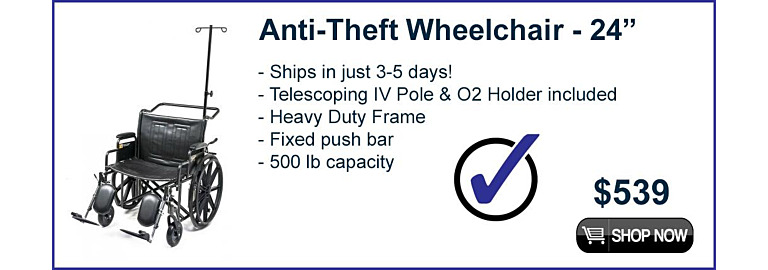Protect Your Patients and Your Practice: The Importance of Anti-Theft Wheelchairs
In the bustling environment of healthcare facilities, ensuring the safety and security of patients is paramount. Yet, despite our best efforts, incidents of theft can occur, posing risks to both patients and the reputation of the clinic or department. One area where theft prevention is particularly crucial is with wheelchairs. These vital mobility aids are essential for many patients, and their theft can cause significant inconvenience and distress. That's why investing in anti-theft wheelchairs is not just a precautionary measure; it's a proactive step towards safeguarding your patients and your practice.
Understanding the Risks:
Theft of wheelchairs may seem like a minor concern compared to other security issues in healthcare settings. However, the consequences can be far-reaching. Consider the following scenarios:
- Patient Discomfort and Inconvenience: For patients who rely on wheelchairs for mobility, having their wheelchair stolen can be deeply distressing. It not only disrupts their ability to move around independently but also compromises their comfort and dignity during their visit to the clinic or department.
- Operational Disruption: In addition to the impact on individual patients, the theft of wheelchairs can disrupt the smooth operation of the clinic or department. Staff may need to spend valuable time searching for replacement wheelchairs or making alternative arrangements, leading to delays in patient care and increased stress for everyone involved.
- Financial Loss: Wheelchairs are valuable assets, and their theft represents a financial loss for the healthcare facility. Replacing stolen wheelchairs can be costly, especially if it becomes a recurring issue. Furthermore, the reputation of the facility may suffer if patients perceive it as unsafe or poorly managed.
Benefits of Anti-Theft Wheelchairs:
Investing in anti-theft wheelchairs offers several key benefits for healthcare facilities:
- Deterrence: Anti-theft wheelchairs are equipped with features specifically designed to deter theft, such as locking mechanisms and tamper-resistant components. The presence of these features can serve as a powerful deterrent to potential thieves, reducing the likelihood of incidents occurring in the first place.
and recovery without worrying about the safety of their belongings.
- Long-Term Cost Savings: While the initial investment in anti-theft wheelchairs may be higher than traditional models, the long-term cost savings can be significant. By preventing theft and minimizing the need for replacements, these wheelchairs ultimately contribute to a more efficient and cost-effective operation.
Conclusion:
In an environment where patient safety and satisfaction are top priorities, the importance of having anti-theft wheelchairs cannot be overstated. By investing in these specialized mobility aids, healthcare facilities can protect their patients, maintain operational efficiency, and uphold their reputation as trusted providers of quality care. Don't wait until theft becomes a problem; take proactive steps to safeguard your patients and your practice today. Visit www.zzmedical.com to learn more.


